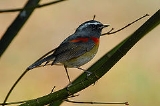
Tarsiger
Encyclopedia
Tarsiger is a genus of six species of bird
s in the family Muscicapidae. They are small, mostly brightly coloured insectivorous
birds native to Asia
and (one species) northeastern Europe
; four of the six species are confined to the Sino-Himalayan mountain system. The genus has sometimes been included within the related genus Luscinia
, but the species have been found to form a distinct monophyletic
group.
The genus contains the following species:
Until recently, the Himalayan Bluetail was treated as a subspecies
of the Red-flanked Bluetail. It was split on the basis of its more intense plumage colours, and its ecology and behaviour, being a short-distance altitudinal migrant not a long distance migrant.
Bird
Birds are feathered, winged, bipedal, endothermic , egg-laying, vertebrate animals. Around 10,000 living species and 188 families makes them the most speciose class of tetrapod vertebrates. They inhabit ecosystems across the globe, from the Arctic to the Antarctic. Extant birds range in size from...
s in the family Muscicapidae. They are small, mostly brightly coloured insectivorous
Insectivore
An insectivore is a type of carnivore with a diet that consists chiefly of insects and similar small creatures. An alternate term is entomophage, which also refers to the human practice of eating insects....
birds native to Asia
Asia
Asia is the world's largest and most populous continent, located primarily in the eastern and northern hemispheres. It covers 8.7% of the Earth's total surface area and with approximately 3.879 billion people, it hosts 60% of the world's current human population...
and (one species) northeastern Europe
Europe
Europe is, by convention, one of the world's seven continents. Comprising the westernmost peninsula of Eurasia, Europe is generally 'divided' from Asia to its east by the watershed divides of the Ural and Caucasus Mountains, the Ural River, the Caspian and Black Seas, and the waterways connecting...
; four of the six species are confined to the Sino-Himalayan mountain system. The genus has sometimes been included within the related genus Luscinia
Luscinia
Luscinia is a genus of smallish passerine birds, containing the nightingales and relatives. Formerly classed as members of the thrush family Turdidae, they are now considered to be Old World flycatchers of the chat subfamily...
, but the species have been found to form a distinct monophyletic
Monophyly
In common cladistic usage, a monophyletic group is a taxon which forms a clade, meaning that it contains all the descendants of the possibly hypothetical closest common ancestor of the members of the group. The term is synonymous with the uncommon term holophyly...
group.
The genus contains the following species:
- White-browed Bush Robin (Tarsiger indicus)
- Rufous-breasted Bush Robin (Tarsiger hyperythrus)
- Collared Bush Robin (Tarsiger johnstoniae)
- Red-flanked BluetailRed-flanked BluetailThe Red-flanked Bluetail , also known as the Orange-flanked Bush-robin, is a small passerine bird that was formerly classed as a member of the thrush family Turdidae, but is now more generally considered to be an Old World flycatcher, Muscicapidae...
(Tarsiger cyanurus) - Himalayan BluetailHimalayan BluetailThe Himalayan Bluetail or Himalayan Red-flanked Bush-robin is a small passerine bird that was formerly classed as a member of the thrush family Turdidae, but is now more generally considered to be an Old World flycatcher, Muscicapidae.It is a short-distance altitudinal migrant species, breeding in...
(Tarsiger rufilatus) - Golden Bush Robin (Tarsiger chrysaeus)
Until recently, the Himalayan Bluetail was treated as a subspecies
Subspecies
Subspecies in biological classification, is either a taxonomic rank subordinate to species, ora taxonomic unit in that rank . A subspecies cannot be recognized in isolation: a species will either be recognized as having no subspecies at all or two or more, never just one...
of the Red-flanked Bluetail. It was split on the basis of its more intense plumage colours, and its ecology and behaviour, being a short-distance altitudinal migrant not a long distance migrant.

